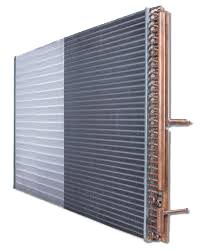Specializing in Superior Quality Coils - Made in the USA
E-mail:
Stay Connected

Condenser Coils are made for heat rejection, such as the heat absorbed by an evaporator coil, and they typically operate under higher internal pressures. Coils made with 3/8-inch tubing are rated for use at 600 PSIG and 300°F while coils made from 1/2- or 5/8-inch tubing are rated for 300 PSIG and 300°F. Condenser coils are sometimes used as part of a heat pump to provide heat in a specific location, but more often they are used to simply exhaust heat energy that is collected elsewhere. These coils are also factory tested to 600 PSIG.
Most condenser coils are designed with either 1/2"or 3/8” O.D. tubes. Condenser coils are sized to handle the cooling load as well as any desired subcooling and also the heat of compression from the compressor. The type of condenser fan being used and its static pressure capability may be a significant determining factor in the coil design. The subcooler circuit (if provided) will often be integrated into the header design.
The most commonly used tube material is copper on condenser coils, and there are a variety of tube wall thickness options to handle different applications. Aluminum is the most frequently used material for the fins on a coil (including condenser coils), because of good heat transfer characteristics and low cost, but copper fins are also common in coastal areas. There are many different fin designs that will either enhance heat transfer or reduce air pressure drop, depending on the requirement (all these are options for condenser coils). Coil frames (or casings, flanges) are normally galvanized. Protective coatings are sometimes utilized in harsher atmospheres such as salt spray or chemical environments. Connections are almost universally made from copper. You are able to request certain materials to be used on a Condenser Coil to fit your needs and climate resistance.
Keep in mind that although there are a huge variety of material options available for coil designs, unless there is a design reason to specify something special, most coils will be purchased based on the cost alone, so using the “standard” coil material is generally the approach to take.
Cleaning condenser coils on your outdoor AC unit will not only help the unit cool more efficiently, but it will also cut down on the power consumption of your AC. It is important to clean the coils early in the year, before the AC unit is needed for the summer.
The outdoor condenser coil of your air conditioner performs a tough job in warm weather. It takes the concentrated heat collected from your home and dumps it into the hot outdoor air. To get rid of the collected heat, your outdoor condenser coil has to move a lot of air. If the coil is dirty or if plants or other objects are too close to the conditioner unit, the fan in the outdoor coil can’t move as much air as required for good performance and efficiency. This raises your electricity cost for air conditioning and may shorten the life of the outdoor condensing unit.
Condenser coils use refrigerant-filled tubes where heat leaves the hot refrigerant vapor. The vapor then condenses into a liquid capable of absorbing more heat.
To get a Heat Condenser Coil price or other custom coils pricing CONTACT US today!







